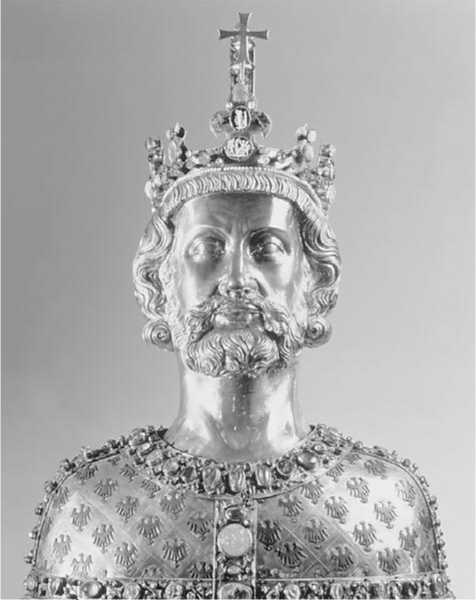While in Italy, Charlemagne visited the former imperial capital of Ravenna, including the Church of San Vitale. Built by the Byzantine invaders, the church must have inspired him, because upon his return to Aachen, he ordered his architect, Odo of Metz, to design a replica. The chapel at Aachen, as it turned out, was not an exact reproduction: it was a much firmer, less delicate building than the original—and thus it helped establish the essentials of Carolingian architecture.

Charlemagne, who ruled from 768 to 814, was the most significant Western European ruler of the Early Middle Ages. Reproduced by permission of the Corbis Corporation.
A number of qualities distinguished the architecture of Carolin-gian times from that of the Merovingian era, when civilization was still hanging by a thread. Merovingian buildings were small and boxlike— like a hut, only bigger and more permanent. Carolingian design, by contrast, incorporated the graceful, open basilica floorplan used by Constantine (emperor of the Roman Empire; ruled 310-37). Thus the Carolingians borrowed Italian concepts for a rougher, hardier northern kingdom,
And laid the groundwork for both Romanesque and Gothic architecture.
The period of Charlemagne's rule saw a rebirth in the arts and learning; hence it is sometimes called the "Carolingian Renaissance." Much of the credit goes to Alcuin (AL-kwin; c. 732-804), an Anglo-Saxon scholar who at Charlemagne's request became head of the school at Aachen. Surveying the deplorable state of education among the future Carolingian leaders, Alcuin called for a return to the study of Latin and of what the Romans had called the seven liberal arts: grammar, rhetoric (the art of writing and speaking), logic, arithmetic, geometry, music, and astronomy.
Charlemagne himself could barely read and write, yet literacy thrived among the upper classes during his reign. By then parchment, a durable type of paper made from sheepskin, had come into use. Many of the Greek and Roman classics had been saved earlier by monks in the British Isles, but Carolin-gian monks copied so many manuscripts themselves that many took their versions for the originals. The monks had developed the Merovingian majuscule into a highly readable script called minuscule. Later, they created a more square version of this script that, because people mistook their manuscripts for Roman originals, came to be called "Roman." A slanted version of "Roman" lettering, used at the Vatican, became the basis for italic—that is, Italian—script.




 World History
World History









